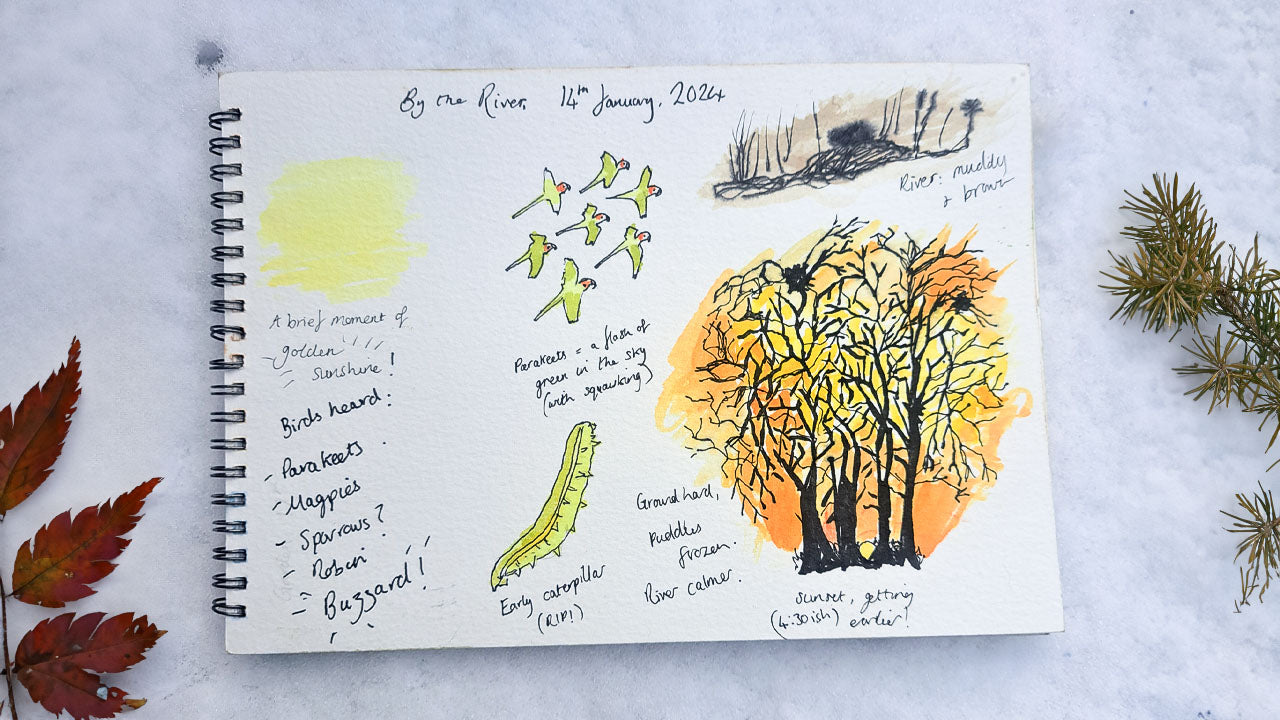
18, January 2024
Nature Journalling for Mindfulness
Being outside in Nature is good for your wellbeing, and so is mindfulness. By starting a Nature journalling habit, you can combine the two. You don’t need to be a writer, a naturalist or an artist – and you could make a difference not just to your own mood, but to Nature itself.
What is Nature Journalling?
Nature journalling means keeping a record of Nature and your relationship with it. It’s about noticing the tiny details in the natural world that you might miss on a regular walk. Pausing to observe, listen and take notes about these things places you in the current moment, making it an effective way to practise mindfulness.
What is Mindfulness?
Mindfulness means focusing your mind and body on the present moment, without judgement and with acceptance. It is often practised through meditation, but there are other methods, including through tai chi or yoga, or even colouring-in.
What is a Nature Journal?
A Nature journal can take the form of a sketchbook, notebook or scrapbook – the important thing to remember is that it’s your personal record of Nature. It might contain notes, sketches, paintings, drawings, poems, fallen leaves or feathers, diary entries, or a mixture of these. Your Nature journal will become a beautiful document about the wild world you’ve experienced and observed, and how it changes through the seasons and over time.

What Are the Benefits of Nature Journalling?
As well as bringing you into the present moment and helping you to be mindful, Nature journalling has many other benefits. Spending time in Nature is widely known to promote feelings of calm and wellbeing, stopping to engage with it even more so. The researchers at the University of Derby’s Nature Connectedness Research Group have found that deeply connecting with Nature not only helps our own wellbeing, but makes us more likely to want to protect the natural world. So, Nature journalling can be good for the planet too.
How to Practise Nature Journalling
To begin, you’ll need the very basics: a pen or pencil and something to write or draw in, like a notebook or a sketchbook.
Head out to a place where you know you’ll find some Nature. It could be a park, some woodland, a riverbank, a garden (a public one or a friend or family member’s, if you don’t have your own). Write the date and the location at the top of the page.
Start with your senses. What can you hear, smell, touch and see? This is a chance for you to be in the moment, to stop and discover something completely new.
Close your eyes for a moment and concentrate on the sounds around you. When you open your eyes, jot down all the noises you noticed: birdsong, water running, wind rustling leaves in trees.
Notice the smells in the air, and write these down, too: grass, soil, perhaps an aroma you haven’t smelt before, from a plant or flower.
What textures can you feel in Nature? From soft, downy leaves to the rough bark of a tree. Bark rubbings are a great way to record the textures of different tree trunks.
What can you see? Look closely at the ground, at vegetation, see if you can spot any insects. If you can, stay still and draw or sketch anything of note. If not, take photographs or make notes and use them to make drawings when you get home.

Nature Journalling Tips
See the Seasons Consider choosing a tree, body of water or other natural landmark to revisit time and again, watching how it changes throughout the year.
No Judgement Don’t worry about how your sketches look, or be afraid of making mistakes: this is your personal Nature journal. If you do want to improve your drawing skills, they will develop naturally if you journal regularly.
Be Curious If you don’t know the name of an interesting fungus or flower you see, or you can’t identify the call of a bird you hear, that’s fine. Describe the thing or write questions about it in your journal and look up the answers later. You’ll learn a lot about Nature this way.
Develop at Home Don’t worry if you can only write down a few words, or make a very basic sketch while you’re outdoors. When you get home, ‘flesh-out’ the basics on your page; paint or shade drawings, and see if any of the words you wrote inspire a poem or piece of prose. Perhaps you glimpsed a bird in the sky and would like to draw a detailed picture of it. Look up that bird and spend some time making a closer study of its shape and colours.
Be Even More Mindful Getting creative while you fill in the details of your journal can be calming in itself. Colouring-in is known to promote mindfulness, so spending time adding colour to your drawings you’re home adds another layer of mindfulness to the journalling process.
Seek Inspiration Search for Nature journalling on social media and online and you’ll find a community of people sharing ideas and inspiration. In this video, Nature journaller Alex Boon explains how the practice can change lives, and his Youtube channel is full of tutorials and advice. Get Out Get Arty is a Nature journalling group based in Shrewsbury, but they offer online sessions and have an online community. The Nature Journaling Week website is packed with tips and ideas. Try Eventbrite and search engines for Nature journalling events and workshops in your area.




